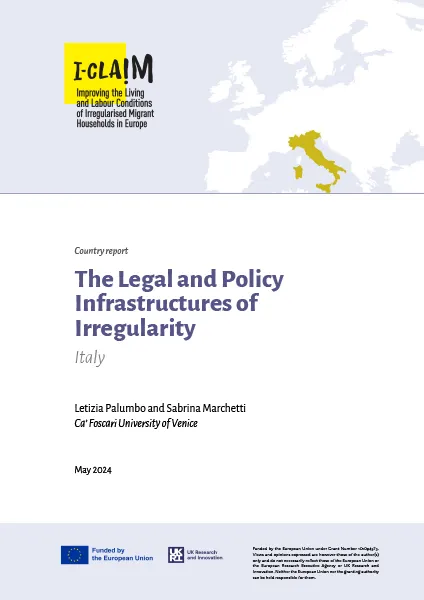The Legal and Policy Infrastructure of Irregularity: Italy
Letizia Palumbo and Sabrina Marchetti
How to cite:
Palumbo, L., Marchetti, S. (2024) The legal and policy infrastructure of irregularity: Italy. I-CLAIM. DOI: https://zenodo.org/records/11208940
The Legal and Policy Infrastructure of Irregularity: Italy
Letizia Palumbo and Sabrina Marchetti
This report is part of the project “I-CLAIM: Improving the living and labour conditions of irregularised migrant households in Europe”, which aims to examine the various forms of irregularity involving migrant people – and particularly migrant workers – the reasons that determine and amplify them, and the repercussions they have on the family dynamics of these individuals.
Building on the concept of ‘irregularity assemblage’, the report critically analyses the political and legal devices and practices, referred to as ‘infrastructures of irregularity’, that have occurred in Italy over the last 20 years (2003-2023) contributing to the production and strengthening of various forms and dynamics of ‘irregularity’. The study considers irregularity as a multi-dimensional condition, referring to not only the absence of a residence permit, but also situations of legal precarious status involving regular migrant people, which can also include situations of undeclared work. The project also focuses on the dimensions of ‘limbo’ and uncertainty caused, for example, by prolonged waiting times for the issuance or renewal of a residence permit or by the lengthy and complex asylum application procedure.
Based on an analysis of European and national legislation, relevant case law, political documents, scholarly literature, and data collected through eight in-depth interviews with key experts and a meeting with relevant national stakeholders, this report explores, from a gender and intersectional perspective, how irregularity is produced and shaped in practice at the intersection of migration, employment, and welfare regimes. It pays special attention to the dynamics of irregularity and exploitation in core sectors such as domestic work and agriculture.
The report highlights how, over the last two decades, by fostering narratives on a ‘migrant invasion’ threating the country, various Italian governments have adopted increasingly stringent migration and asylum policies. These policies have contributed to the ‘production of irregularity’ by narrowing the goalposts of regular channels and protection, and pushing individuals who are regular residents into an even more precarious status.
Firstly, there has been a progressive tightening of access to asylum in Italy, especially with the adoption of the 2018-2019 ‘Security’ Decrees (also named ‘Salvini’ Decrees) and, more recently, with the recent Law Decree 20/2023, the so-called ‘Cutro Decree’, which, among other things, has restricted the scope of the so-called ‘special protection’ (former ‘humanitarian protection’). All these restrictive reforms have either contributed to or, in the case of recent ones, are expected to lead to a growing number of people living in irregular situations. In this context, however, important judicial decisions have significantly challenged stringent national legislative and policy interventions. Additionally, challenges to restrictive national migration and asylum policies have also involved local actions taken, for instance, by some municipalities.
Secondly, the report underlines how the national entry system for third-country nationals (the Flows Decree system) serves as a legal device that fosters dynamics of irregularity and facilitates abusive and exploitative practices. For example, the data from our research reveal that many migrant people who arrived in Italy through the Flows Decree have not been hired by the employer or have fallen victim to scams, and so risk losing the opportunity to stay regularly in Italy.
Thirdly, the report highlights the challenges faced by migrant individuals lacking a residence permit or having precarious legal status in accessing fundamental rights, such as the right to health. We also underline how many migrant individuals find themselves in a bureaucratic limbo that hinders their regularisation process and access to healthcare or welfare measures. For example, despite the law stating that, during the renewal process of the residence permit, migrants should be enrolled in the national healthcare system and be able to benefit from family support measures such as the universal child benefit, many public administration offices do not allow it. All this significantly affects the living and working conditions of migrant people, especially single migrant mothers.
Finally, by focusing on the interplay between migration, employment, and the welfare regime in Italy, the report highlights how forms of irregularity and exploitation involve not only migrant workers without residence permits but also non-EU citizens with regular residence, including asylum seekers, and EU citizens from less prosperous EU countries such as Romania and Bulgaria. In this context, the dynamics of irregularity and exploitation stem from the different situations of vulnerability experienced by migrant workers, within a context of structural and intersecting inequalities related to gender, nationality, class, skin colour, and legal status.
Sectors such as for instance domestic work and agriculture rely on the employment of a racialised, gendered, and legally stratified migrant labour force, and are characterised by weak labour rights protection, high rates of undeclared work, and exploitative dynamics. The report underscores how these dynamics are exacerbated in the case of women workers due to gender discrimination and abuse. In particular, pressures related to family and care responsibilities, which still predominantly fall on women’s shoulders, along with the lack of fair employment alternatives, lead many women to ‘accept’ undeclared work and forms of exploitation, which also often involve gender and sexual abuse.
In recent years, there have been several institutional interventions aimed at addressing the exploitation of migrant workers, especially in the agricultural sector. However, little has been done in terms of structural actions. Furthermore, the majority of these interventions lack a gender and intersectional perspective.
